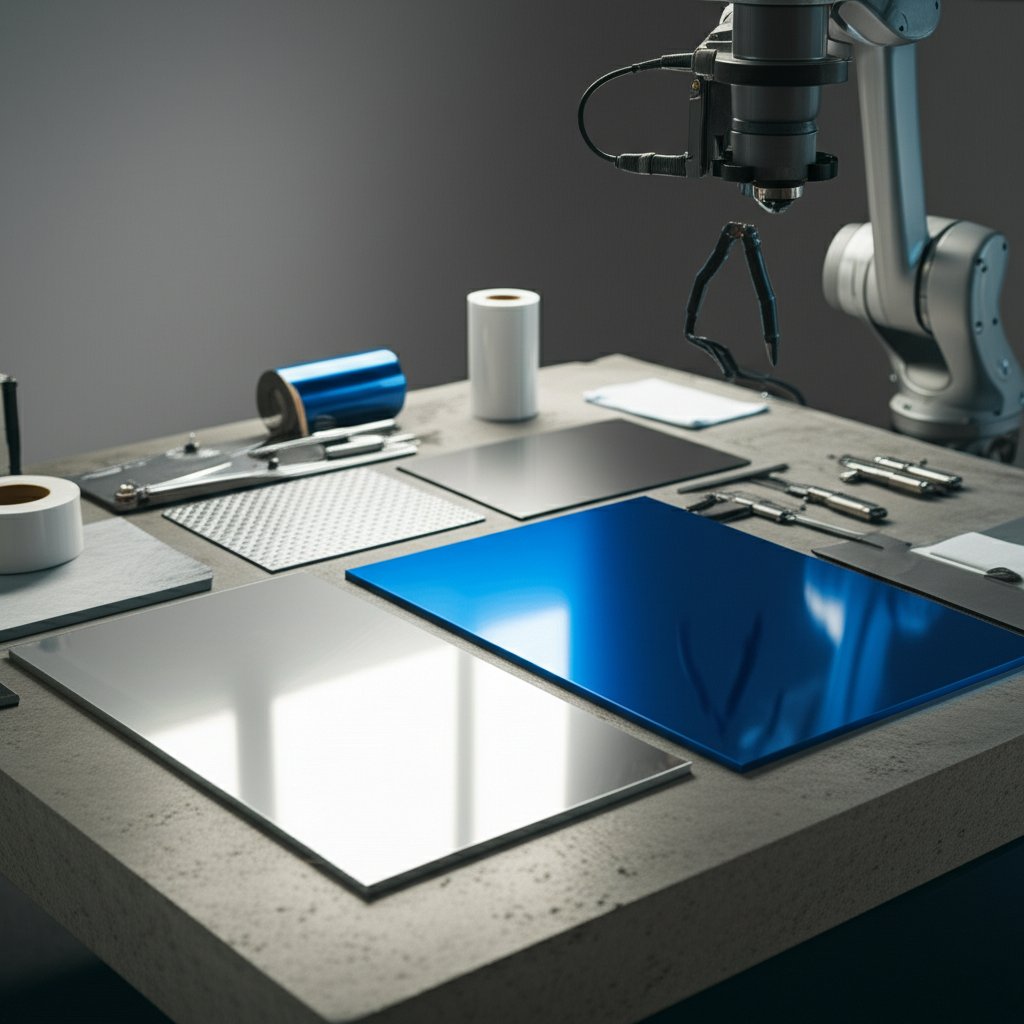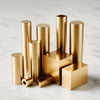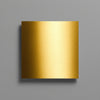Aluminium Sheet Sizing Decoded: Gauge, Thickness, 4x8 Made Easy

Aluminium Sheet Fundamentals and Use Cases
What aluminium sheet means in standards
When you start sourcing materials for your project, you’ll quickly notice terms like aluminium sheet, plate, and foil used interchangeably. But what do these mean in industry standards? According to ASTM B209, aluminium sheet and plate are defined primarily by their thickness, though the standard focuses more on performance and composition than on rigid size cutoffs. Most suppliers in the US categorize sheet as material between 0.5mm and 6mm thick, while anything above that is typically called plate. Foil, on the other hand, falls below 0.2mm. These categories help ensure you get the right product for your application and simplify communication with suppliers.
Sheet vs plate vs foil
| Type | Typical Thickness Range | Common Uses | Sourcing Notes |
|---|---|---|---|
| Aluminium Foil | Below 0.2mm | Packaging, insulation, decorative wraps | Usually in rolls, for light-duty applications |
| Aluminium Sheet | 0.5mm to 6mm | Panels, enclosures, signage, automotive bodywork, appliances | Flat sheets or cut-to-size, widely stocked |
| Aluminium Plate | Above 6mm | Structural frames, heavy-duty parts, aerospace, marine | Usually cut to order, for high-strength needs |
While these ranges are typical, always check with your supplier as definitions may vary. The key takeaway: sheet is your go-to for medium-thickness, versatile applications, while plate is reserved for when extra strength or depth for machining is required. Foil is best for lightweight, flexible needs.
Core properties and where they matter
Why is aluminium sheet so widely used? Imagine you’re designing a new product—what makes sheet aluminum stand out? Here are the core properties that drive its popularity:
- Lightweight: Aluminium is much lighter than steel, making handling and installation easier, especially for large panels or mobile applications.
- Corrosion Resistance: A natural oxide layer protects it from rust, so it’s ideal for outdoor, marine, or humid environments.
- Good Conductivity: Aluminium sheets conduct heat and electricity well, supporting roles in enclosures, heat exchangers, and electronics.
- Formability: You can easily cut, bend, or shape aluminium sheets without cracking, making them a favorite for custom fabrication.
- Recyclability: Aluminium is 100% recyclable without losing quality, supporting sustainable, eco-friendly projects.
- Surface Finish Options: From brushed to anodized, aluminium sheets offer a range of looks for both decorative and functional use.
Common applications across industries
Still wondering where aluminum sheet or aluminium sheets fit in real-world projects? Here are some practical examples:
- Construction & Architecture: Building facades, roofing, wall panels, and window frames benefit from aluminium’s combination of strength and corrosion resistance.
- Automotive: Car body panels, engine covers, and structural supports use sheet aluminum for weight savings and durability.
- Aerospace: Fuselage skins, wing panels, and interior structures rely on the high strength-to-weight ratio of aluminium sheeting.
- Marine: Boat hulls and offshore structures use aluminium sheets for corrosion resistance in saltwater environments.
- Signage & Displays: Outdoor signs, billboards, and display boards leverage the weather resistance and easy fabrication of aluminium sheets.
- Electrical: Enclosures, busbars, and heat sinks take advantage of aluminium’s conductivity and formability.
- Household: Appliances, kitchen utensils, and decorative panels all use aluminium sheeting for its clean look and practicality.
Choose sheet for enclosures and panels; choose plate when stiffness and machining depth dominate.
Compared to steel sheet, aluminium sheet offers significant weight savings, superior corrosion resistance, and is generally easier to form or cut. Whether you’re sourcing aluminum sheeting for a new product or specifying aluminium plate for a structural frame, understanding these distinctions ensures you select the right material for your needs.

Alloy and Temper Selection Made Simple
Choosing Between 3003, 5052, and 6061
Ever wondered why some aluminium sheet bends easily while others feel stiff or resist corrosion in salty air? The secret is in the alloy and temper you choose. Let’s break down the three most common options—3003 aluminum, 5052 aluminum sheet, and 6061 aluminum sheet—so you can match your material to your project’s needs with confidence.
| Alloy | Strength/Formability | Corrosion Resistance | Weldability | Finish Suitability | Typical Applications |
|---|---|---|---|---|---|
| 3003 | Excellent formability; moderate strength | Very good, especially in humid/chemical environments | Very good | Good for painting, anodizing, decorative finishes | Signage, architectural panels, cookware, storage tanks |
| 5052 | Good formability; higher strength than 3003 | Excellent, especially in marine environments | Very good | Good for painted/anodized finishes | Marine panels, transportation, fuel tanks, enclosures |
| 6061 | High strength; moderate formability | Good, but less than 5052 in saltwater | Good | Excellent for anodizing, machining, and structural finishes | Structural brackets, frames, machined parts, aerospace |
According to industry comparisons, 3003 is your go-to for projects needing high formability and moderate strength, 5052 stands out in marine or harsh environments due to its superior corrosion resistance, and 6061 is best when you need strength and precise machining.
Temper Basics and Why They Matter
Sounds complex? Not really—once you know the basics. Every aluminium sheet metal comes with a temper designation, like H14 or T6, which describes how it was processed to achieve its final properties. Here’s a quick guide:
- H-Series (Work-Hardened): Common for 3003 and 5052. More “H” means harder and stronger, but less bendable. Example: 3003-H14 is harder than 3003-H12.
- T-Series (Heat-Treated): Used for 6061. T6 is the most common, providing high strength but requiring a larger bend radius to avoid cracking.
What does this mean for your project? Softer tempers (lower numbers) are easier to bend and form, while harder tempers (higher numbers) resist deformation but need more careful handling during fabrication. When in doubt, ask your supplier for guidance or request a sample to test bendability before placing a bulk order.
Strength vs Formability Tradeoffs
Imagine you’re designing a curved panel for a display. If you pick a high-strength alloy like 6061-T6, you’ll get durability but may struggle with tight bends. On the other hand, 3003-H14 bends easily but won’t be as stiff. 5052 offers a balanced middle ground—good strength, still formable, and excellent for parts exposed to weather or vibration. Always consider the forming steps and final use environment before locking in your material.
Corrosion and Finish Considerations
Will your aluminium sheet face saltwater, chemicals, or just the occasional rain? 5052 excels in marine and coastal environments, while 3003 is reliable for most indoor and outdoor uses. 6061, while strong, is less corrosion-resistant than 5052 in salt-laden air, so it’s better for structural or machined parts kept away from harsh exposure. All three alloys accept finishes like painting and anodizing, but 6061 is especially prized for its crisp, clean anodized look in architectural and machined components.
- Is your application exposed to moisture, chemicals, or saltwater?
- Do you need to bend or form complex shapes?
- Will your part be painted, anodized, or left with a natural finish?
- Do you plan to weld or machine your aluminium sheet metal?
Always verify your alloy and temper against ASTM B209 or relevant AMS/QQ specifications before procurement to ensure performance and compatibility.
Next, we’ll demystify how to specify aluminium sheet sizes, gauges, and thicknesses so you avoid costly rework and get exactly what your design needs.
Sizes, Gauge, and Thickness That Fit Your Design
Understanding Gauge Versus Thickness
Ever been confused by terms like “16 gauge” or “.063-inch” when shopping for aluminium sheet? You’re not alone. Gauge is a legacy sizing system—each metal has its own chart, so 16 gauge aluminum is not the same thickness as 16 gauge steel. For true engineering accuracy, always specify aluminum sheet thickness in decimals (inches or millimeters). Decimal thickness gives you the precision needed for CAD drawings, fabrication, and fit-up, while gauge is best used as a general reference. As Cut2SizeMetals points out, decimal thickness is consistent, while gauge values can shift between materials.
| Aluminum Sheet Gauge | Thickness (inches) | Thickness (mm) |
|---|---|---|
| 10 | 0.1019 | 2.588 |
| 12 | 0.0808 | 2.052 |
| 14 | 0.0641 | 1.628 |
| 16 | 0.0508 | 1.290 |
| 18 | 0.0403 | 1.024 |
| 20 | 0.0320 | 0.813 |
| 22 | 0.0253 | 0.643 |
| 24 | 0.0201 | 0.511 |
| 26 | 0.0159 | 0.404 |
Why 4x8 Matters in Sourcing and Nesting
When you’re ready to order, you’ll notice “aluminum sheet 4x8” or “4x8 aluminum sheets” are everywhere. Why? The 4 foot by 8 foot size (about 1220mm x 2440mm) is the industry standard, making quoting, shipping, and nesting parts much simpler. This common format means you can maximize sheet yield and minimize waste, especially for projects needing multiple parts cut from a single sheet. While custom sizes are available, sticking to sheet aluminum 4x8 usually saves time and money. Other formats—like 5x10 or 5x12—can be useful for oversized parts or special layouts, but 4x8 remains the most efficient for logistics and fabrication in most cases.
Selecting the Right Thickness for Stiffness
Choosing the right thickness is about balancing strength, weight, and cost. Thicker sheets (lower gauge numbers) offer more stiffness—great for panels that need to resist “oil-canning” (wavy distortion) or for structural covers. Thinner sheets are lighter and easier to cut or form, perfect for decorative panels, enclosures, or where weight is a concern. For example, if you’re building a sign or a machine guard, a mid-range thickness (like 0.063" or 1.6mm) is often ideal. Need more rigidity? Go up to 0.125" (3.2mm). But remember: thicker sheets mean more weight and higher cost, so match your choice to your project’s real needs.
Tolerances and Flatness Considerations
Ever had parts not fit because the material was too thick or warped? That’s where tolerances matter. Each aluminum sheet 4x8 comes with manufacturing tolerances—small allowed variations in thickness and flatness. According to industry guides, standard thickness tolerances for aluminum sheets can range from ±0.03mm to ±0.24mm, depending on the thickness and width of the sheet. Flatness is just as important: large or thin sheets are more prone to warping, especially after cutting or forming. Protective films or paper interleaves are often used to keep the surface pristine during handling and fabrication. Always check with your supplier for mill certificates and request thickness and flatness tolerances per ASTM B209 if your application is sensitive to fit or finish.
- Specify thickness in decimals (inches or mm) for accuracy
- Choose the alloy that fits your environment and fabrication needs
- Select the right temper for forming or machining
- Pick your sheet size (4x8 is standard, but ask about custom)
- Decide on surface finish or protective film
- Request thickness and flatness tolerances if critical
- Confirm quantity and delivery timing
Tip: Always double-check sheet thickness after removing protective film—measuring over the film can give false readings and lead to costly mistakes.
By understanding aluminum sheet gauge, thickness, and standard 4x8 sizing, you’ll avoid rework, reduce waste, and get exactly what your design demands. Next, let’s walk through the practical steps for fabricating, cutting, and finishing your chosen aluminium sheet.

Proven Fabrication Workflow from Cut to Finish
When you’re ready to transform aluminium sheet into finished parts, the journey from raw material to polished component involves a series of precise, safety-conscious steps. Whether you’re working with thin aluminum sheet for decorative panels or robust 1/8 in aluminum sheet for structural applications, understanding each stage helps you avoid costly mistakes and ensures professional results.
- Material Receipt: Accept delivery and verify the correct alloy, thickness (e.g., 1/16 aluminum sheet, 3/16 aluminum sheet), and surface condition. Inspect protective films for damage or moisture.
- Inspection: Check for flatness, dents, scratches, or water staining. If delivered wet, dry thoroughly before storage to prevent corrosion or aesthetic issues.
-
Cutting: Choose a method based on sheet thickness and part geometry:
- Shear/Guillotine: Fast, straight cuts for standard sizes like 1 8 aluminum sheet 4x8; minimal heat, but may leave burrs.
- Laser Cutting: Precise, ideal for intricate shapes in thin aluminum sheet; may create a heat-affected zone (HAZ).
- Waterjet Cutting: No heat distortion, clean edges, suitable for thicker or heat-sensitive sheets.
- Router/Nibbler: Flexible for curves or small features, but may produce rougher edges or more burrs.
- Sawing: Carbide-tipped blades recommended for thicker stock; use lubricant to avoid loading and gummy edges [Empire Abrasives].
- Forming: Use clean, radiused tooling to prevent surface marks and cracking. Gradual bends in steps help control springback—especially in harder tempers or thicker sheets like 1/8 aluminum sheet. Always test minimum bend radius on a scrap piece to avoid unexpected cracks.
- Deburring: Remove sharp edges from cutting and punching. Use files, deburring blades, or abrasive flap wheels. For a brushed finish, progress through finer grits (e.g., 80 to 240) to set a uniform grain.
- Cleaning: After deburring, wipe with solvent (acetone or mild detergent) to remove grease, dust, and chips. Avoid alcohol, which can react with aluminium.
- Finishing: Apply the desired surface treatment—anodizing, painting, or powder coating—after ensuring the sheet is clean and dry. For a satin or matte look, use fine abrasive belts or nonwoven pads.
- Final Inspection: Check dimensions, surface quality, and finish consistency before assembly or delivery. Confirm that all protective films and edge preparations are intact.
Cutting Methods: Pros, Cons, and Best Use Cases
| Method | Pros | Cons | Recommended Uses |
|---|---|---|---|
| Shear/Guillotine | Fast, no heat, low cost | Straight cuts only, burrs may form | Standard panels (e.g., 1 8 aluminum sheet 4x8) |
| Laser | High precision, complex shapes | HAZ possible, higher cost | Thin aluminum sheet, intricate cutouts |
| Waterjet | No heat, smooth edge, versatile | Slower, uses water/abrasive | Thick or heat-sensitive sheets |
| Router/Nibbler | Flexible shapes, portable | Rougher edge, more burrs | Curved or irregular profiles |
| Sawing | Good for thick stock, straight or curved | Edge burrs, blade loading | 3/16 aluminum sheet, 1/8 in aluminum sheet, bar/angle cuts |
Forming and Bending: Essentials for Success
When bending aluminium sheet, always match your approach to the alloy and temper. Softer tempers and thinner sheets (like 1/16 aluminum sheet) bend more easily, while harder or thicker types require larger radii and more gradual forming. Clean tooling prevents surface defects, and gradual forming minimizes cracking and springback. For best results, always test your bend on a sample strip first—especially for 1/8 aluminum sheet or thicker stock.
Deburring and Surface Prep Workflow
After cutting and forming, sharp burrs and oxide layers can interfere with assembly and finishing. Deburr using appropriate tools: files for straight edges, flap wheels for curves, and nonwoven pads for blending. Progress through finer grits for a consistent surface, especially before painting or anodizing. Clean thoroughly to remove dust and grease, as residues can affect coating adhesion and corrosion resistance.
Safety, Handling, and Storage
- Wear cut-resistant gloves when handling all aluminium sheets, especially after cutting.
- Remove protective film just before fabrication to avoid surface scratches.
- Store sheets vertically in a dry, clean environment to prevent water staining and denting.
- Use racks or padding to separate sheets and avoid contact with steel or other metals, which can cause contamination or corrosion.
Common Mistakes to Avoid
- Bending across the grain without a test coupon—risk of cracking increases.
- Skipping edge prep before coating—can lead to poor adhesion.
- Measuring thickness with protective film still on—removes accuracy.
- Storing in damp conditions—invites water staining or corrosion, especially for thin aluminum sheet.
- Using steel tools or brushes—may cause surface contamination.
Always validate your bend allowances and forming approach on a test strip before running full batches—especially with 1/8 in aluminum sheet or new alloys.
By following this structured workflow, you’ll achieve consistent, high-quality results whether you’re fabricating thin aluminum sheet for electronics or a robust 1 8 aluminum sheet 4x8 panel for structural use. Up next, we’ll dive into best practices for machining and drilling aluminium sheet—ensuring clean holes, crisp edges, and minimal distortion every time.
Machining and Drilling Techniques That Work for Aluminum Sheet Metal
Tooling Choices for Clean Cuts and Holes
When you need precise holes or crisp milled edges in aluminum sheet material, the right tooling makes all the difference. Imagine you’re working with thin aluminum sheet metal—the wrong drill or end mill can quickly cause burrs, distortion, or even ruined parts. So, what should you reach for?
- Carbide End Mills (2–3 flute, high helix, polished): These are the gold standard for milling alu sheet metal. The high helix angle (40–45°) and polished surface promote fast chip evacuation and a smooth finish. Fewer flutes mean larger chip gullets, which help prevent clogging—a common issue with sheet metal aluminum.
- Special Coatings (DLC, TiB2, ZrN): Choose end mills and drills with coatings designed for aluminum. These reduce friction, minimize built-up edge (BUE), and extend tool life. Avoid TiN or TiAlN coatings, which can react poorly with aluminum.
- HSS Drills (for short runs or softer alloys): High-speed steel bits work for limited production or softer grades, but carbide outlasts and outperforms them in most cases.
- 118–130° Split-Point Drills: These reduce walking when starting a hole and are ideal for drilling through aluminum metal sheet. They also help minimize burr formation at entry and exit.
Feeds, Speeds, and Cooling for Thin Stock
Ever wondered why aluminum sometimes welds itself to your cutter? That’s built-up edge—and it’s the main enemy of clean machining. For thin aluminum sheet metal, you’ll want to:
- Use high surface speeds: Carbide tools can handle 200–600 meters per minute (m/min), which is 2–3 times faster than steel. Softer alloys like 6061 can be run more aggressively, while harder ones like 7075 need lower speeds.
- Set moderate to high feed rates: Aim for 0.1–0.5 mm per tooth to ensure cutting, not rubbing. Increase feed if you see BUE forming.
- Apply coolant or mist: Never machine aluminum dry. Use water-soluble coolants (6–10% concentration) or an air blast to keep tools cool and chips moving. This reduces friction, prevents chip welding, and helps maintain tolerances.
- Support thin sheets: Use backup boards under the workpiece when drilling through alum sheet metal to prevent burr volcanoes and distortion.
| Alloy | Recommended Cutting Speed (m/min) | Feed per Tooth (mm) | Tool Type |
|---|---|---|---|
| 6061 | 200–600 | 0.1–0.5 | Carbide, 2–3 flute, polished |
| 7075 | Lower end of 200–600 | 0.1–0.3 | Carbide, ZrN/DLC/TiB2 coated |
| 1100/3003/5052 | 300–600 | 0.2–0.5 | Carbide or HSS (short run) |
Drilling and Chip Control Best Practices
Drilling holes in aluminum sheet material can be deceptively tricky. To get clean, accurate holes:
- Use sharp, split-point drills (118–130°) to reduce walking and burrs.
- Apply light, steady pressure—too much force causes BUE and rough holes.
- Employ peck drilling cycles for deeper stacks or thick sheets to clear chips and keep the hole cool.
- Support the exit side with a backup board to prevent “volcano” burrs on the far side.
- Lubricate with water-based or petroleum-based coolants (such as soluble oil or WD-40) to minimize friction and heat.
Troubleshooting Chatter and Burring
Ever notice a chattery finish or stubborn burrs after machining sheet metal aluminum? Here’s how to diagnose and fix the most common issues:
-
Chatter:
- Reduce tool overhang—keep your cutter as short as possible.
- Increase feed rate if possible; low feed can cause rubbing and vibration.
- Check workholding—make sure the sheet is well-supported and clamped.
-
Burring:
- Use sharper tools or replace dull ones.
- Increase feed or reduce speed to avoid heat buildup.
- Always use a backing board for through-holes in thin stock.
- Deburr edges immediately after machining to prevent injury and improve finish.
Increase feed before lowering speed to fight built-up edge in aluminium.
By selecting the right tools, dialing in your feeds and speeds, and supporting your alu sheet metal properly, you’ll achieve burr-free holes, smooth edges, and distortion-free parts. Next, we’ll explore joining and finishing techniques that help your aluminium sheet projects stand up to real-world use and look great for years to come.
Joining and Finishing That Last and Look Right
Welding Choices: MIG, TIG, and Cautions
When you’re ready to assemble your aluminium sheet project—whether it’s a sleek aluminum panel, a robust enclosure, or decorative aluminium sheet for signage—choosing the right joining method is crucial. Welding is a popular option, but it comes with its own set of challenges. MIG (Metal Inert Gas) welding is prized for speed and efficiency, making it a go-to for thicker or production work. TIG (Tungsten Inert Gas) welding, on the other hand, offers superior control and is ideal for thin gauges and visible seams where appearance matters. If you’re working with thin anodized aluminum sheet metal, TIG gives you the finesse needed to avoid burn-through or unsightly warping.
-
Pros:
- MIG: Fast, suitable for thicker panels, easier to automate
- TIG: Precise, clean welds, perfect for thin or decorative aluminum sheet
-
Cons:
- Both require oxide removal before welding for best results
- Thin aluminium steel sheet can distort if not properly fixtured
- Special fillers (like ER4043 or ER5356) may be needed for different alloys and corrosion requirements
Always confirm your welding procedure meets AWS D1.2 standards for aluminium and consider skip welding or fixturing to minimize distortion on thin stock. For advanced needs, friction stir welding and laser welding are also options, especially for high-strength or multi-material assemblies.
Mechanical Fastening and Adhesive Bonding
Not every aluminium sheet project calls for welding. Mechanical fastening—using blind rivets, clinch nuts, or screws—is often the best choice for quick assembly, field repairs, or when you want to avoid heat distortion. If your application involves combining aluminium with steel (as in some aluminium steel sheet constructions), always use insulating washers or coatings to prevent galvanic corrosion.
-
Pros:
- Fast, repeatable, and easy to disassemble for maintenance
- Works well for joining dissimilar materials or layered assemblies
-
Cons:
- May require overlapping joints, which can add bulk
- Potential for galvanic corrosion if aluminum contacts bare steel
Adhesive bonding is another strong option, especially for decorative aluminum sheet or panels where you want a clean, fastener-free look. Modern structural adhesives offer impressive strength and durability, but surface prep is key. Clean, degrease, and roughen the surface, and consider anodizing for the best bond.
-
Pros:
- Distributes stress evenly, maintains aesthetics
- Allows joining of thin or dissimilar materials without distortion
-
Cons:
- Requires careful surface prep (cleaning, etching, anodizing)
- Cure times may slow production
Anodizing, Painting, and Mechanical Finishes
Finishing your aluminium sheet is about more than just looks. The right finish can dramatically boost corrosion resistance, durability, and even electrical properties. Here’s how the main options stack up:
| Finish Type | Durability | Appearance | Reworkability | Cost Tier |
|---|---|---|---|---|
| Anodizing (clear/colored) | Excellent | Matte, metallic, color options (e.g., black aluminum sheet metal, white aluminum sheet) | Hard to rework once applied | $$ |
| Powder Coating | Excellent | Glossy/matte, wide color range, good for decorative aluminium sheet | Possible to strip and recoat | $$ |
| Chromate Conversion | Moderate | Yellow/green tint, subtle | Not designed for aesthetics | $ |
| Mechanical (brushed, bead blasted) | Good (surface only) | Satin, textured, ideal for decorative aluminum sheet | Easy to rework or refresh | $ |
For outdoor or marine environments, anodizing and powder coating both deliver outstanding protection. Anodized aluminum sheet metal is especially popular in architectural and decorative applications for its durability and vibrant color options. Powder coating, meanwhile, offers even more color flexibility and a thicker, tougher barrier—ideal for high-traffic or industrial settings.
Corrosion Protection by Environment
Where will your aluminium sheet live? For marine or coastal installations, prioritize anodizing or powder coating to shield against salt and moisture. In industrial settings, chromate conversion can add conductivity and moderate protection—especially for components that need to be grounded. For architectural or decorative projects, both anodized and powder-coated finishes provide long-lasting color and corrosion resistance, making them the top picks for white aluminum sheet, black aluminum sheet metal, and other specialty finishes.
- Marine/Outdoor: Anodizing or powder coating for maximum longevity
- Industrial: Chromate conversion for conductivity, powder coat for abrasion resistance
- Architectural/Decorative: Anodized or powder-coated decorative aluminium sheet for appearance and durability
Don’t forget: Isolating aluminium from dissimilar metals (like steel in an aluminium steel sheet assembly) with gaskets or coatings is vital to prevent galvanic corrosion in harsh environments.
Prep drives coating success—cleanliness and conversion coatings matter as much as the paint.
By understanding your joining and finishing options, you’ll ensure your aluminum panel or decorative aluminum sheet project stands up to the elements and looks great for years. Up next, we’ll help you navigate sourcing and pricing strategies so you get the best value from your aluminium sheet investment.

Sourcing Strategy, Pricing, and Total Cost Control for Aluminium Sheet
What Drives Aluminium Sheet Cost?
Ever wondered why aluminum sheet price quotes can vary so much—even for the same size and alloy? The answer lies in a mix of visible and hidden factors. At the core, the base metal price—often tracked on the London Metal Exchange (LME)—sets the starting point, but that’s just the beginning. Processing fees (for cutting, finishing, or custom sizing), alloy and temper selection, sheet thickness, and even your region all influence the final metal sheet price. For example, thicker or larger sheets cost more due to higher material and processing needs, while premium alloys or tight tolerances add to the cost. Market volatility can swing prices by up to 20% per quarter, making timing and sourcing strategy critical. Supply and demand, tariffs, and shipping costs further complicate the picture.
Spec Choices That Impact Price
Choosing the right specs for your project is about more than just picking a size off the shelf. Imagine you’re ordering aluminum sheet prices 4x8 for a batch of panels. Opting for a standard 4x8 size can save you money, as these are mass-produced and widely stocked. Custom sizes or unusual thicknesses usually come with higher processing fees, longer lead times, and potential minimum order quantities. Surface finish (brushed, anodized, or painted), tight tolerances, and protective coatings all add to the aluminum sheet cost. If you need a specialty alloy or temper, expect a premium—especially if it’s not a high-volume item for your supplier.
Logistics, Scrap, and Yield Management
Sounds complex? It can be, but a smart sourcing approach can make a big difference. Consider these hidden cost drivers:
- Nesting Efficiency: Sticking to common sizes like 4x8 reduces scrap when cutting parts, improving your net yield per sheet and lowering overall sheet metal pricing.
- Packaging and Handling: Proper packaging prevents surface damage and water staining, especially for decorative or architectural applications.
- Rework and Scrap Recovery: Mistakes in cutting or fabrication can turn valuable material into waste. Some suppliers offer scrap buyback or recycling programs—factor this into your total cost of ownership (TCO).
- Logistics: Shipping costs can vary by region and order size. Bulk orders may qualify for better rates, but oversized or heavy sheets increase freight charges.
| Scenario | Visible Price | Hidden/TCO Factors |
|---|---|---|
| Prototype | High per-sheet | Setup fees, small-quantity surcharges, minimal scrap recovery |
| Small Batch | Moderate | Better yield, some volume discount, moderate packaging/logistics |
| Production | Lowest per-sheet | Maximized nesting, bulk freight rates, scrap recovery, quality assurance costs |
Recyclability and Lifecycle Value
Aluminium’s recyclability is a hidden value driver. Choosing recyclable alloys and working with suppliers who offer scrap buyback can offset the cost of 4x8 sheet of aluminum over time. Secondary (recycled) aluminum sheets often provide substantial savings for non-cosmetic or coated applications, with no compromise in structural performance. For projects with sustainability goals, ask about recycled content and lifecycle certifications.
Smart Sourcing: How to Get the Best Value
- Consolidate specs across projects to boost order volume and qualify for better pricing.
- Allow alternates for alloy or finish when non-critical—this opens up surplus or secondary stock options.
- Target common alloys, tempers, and sheet sizes (like 4x8) for the best aluminium sheet price and availability.
- Request mill certifications and ASTM B209 conformance for quality assurance.
- Compare quotes from local suppliers, online platforms, and distributors—don’t just chase the lowest metal sheet price if it means sacrificing reliability or service.
Price your parts on net yield, not raw sheet price.
By looking beyond the sticker price and considering TCO factors—like nesting efficiency, scrap recovery, and logistics—you’ll make smarter sourcing choices and control the true cost of aluminium sheet in your projects. Next, we’ll explore when precision CNC work adds value and how to prepare your aluminium sheet designs for advanced manufacturing.
When Precision CNC Adds Value to Aluminium Sheet Projects
When to Choose CNC Over Routing or Laser?
Ever wondered if your next aluminium sheet design really needs CNC machining? Imagine you’re working with aluminum 4 x 8 sheets and your part calls for tight-tolerance slots, countersunk holes, or multi-step pockets. That’s where CNC machining shines—delivering features and accuracy that basic routing or laser cutting can’t match. While CNC routing is ideal for fast, 2D work on flat panels, and laser excels at intricate outlines in thin stock, CNC machining is your go-to for:
- Complex 3D features—think stepped pockets, deep slots, or edge profiles that go beyond simple cuts
- Precise threads, countersinks, or tapped holes directly in aluminum sheet metal 4x8
- Multi-axis features—like chamfers, fillets, or intersecting holes that require tool access from different angles
- Hybrid designs that blend sheet and plate elements, or require pockets milled to exact depths
According to Xometry, CNC mills offer greater freedom in the Z-axis and are best for complex contours and individual parts, while routers are best for flat stock and panels. So, if your aluminium sheet 8 x 4 project is more than just a cutout, CNC machining could be the edge you need.
Tolerances, Features, and Repeatability
Why does CNC matter for repeatability? When you specify features like precision slots or small-diameter holes in 4x8 aluminum sheet metal, CNC machines deliver consistent results—part after part. Tolerances as tight as ±0.005mm are possible with advanced 4- and 5-axis equipment, especially when working with high-grade alu sheet stock. This is critical if you’re building assemblies that must align perfectly or require post-machining processes such as anodizing, where dimensional stability is key.
| Manufacturing Option | Accuracy | Edge Quality | Feature Complexity | Lead Time | Cost Tier | Pros | Cons |
|---|---|---|---|---|---|---|---|
| CNC Machining (XTJ) | Ultra-high (±0.005mm possible) | Excellent (machined finish, no HAZ) | Very high (4/5-axis, deep pockets, threads) | 3–10 days | $$$ | Certified quality, rapid prototyping to production, engineered support | Higher cost for simple 2D parts |
| CNC Routing | Moderate (±0.1–0.25mm typical) | Good (minor burrs, no HAZ) | Medium (mostly 2.5D, limited Z-depth) | 2–7 days | $$ | Fast for panels, large sheet processing | Limited for deep or complex features |
| Laser Cutting | High (±0.05–0.2mm typical) | Excellent (clean, heat-affected edge) | Low (2D outlines, holes, slots) | 1–5 days | $–$$ | Fast, precise for thin sheets of aluminum | No 3D or threaded features, HAZ possible |
| Waterjet | High (±0.1–0.3mm typical) | Very good (no HAZ, slight taper) | Low–Medium (2D, some 2.5D) | 2–7 days | $$ | No heat distortion, thick stock possible | Slower, limited feature complexity |
From Prototype to Production: Streamlining Your Workflow
Planning to move from a single prototype to a production run of aluminium 4x8 sheet parts? CNC machining offers a smooth transition. You can iterate quickly on a single part, validate fit and function, then scale up—confident that each piece will meet the same high standards. Services like XTJ CNC Machining are equipped with ISO 9001 & IATF 16949 certifications, ensuring quality from your first prototype through to full-scale production. Their 4- and 5-axis capabilities enable rapid turnarounds and the ability to handle even the most challenging alu sheet geometries.
How to Prepare Manufacturable CAD for CNC
Want to avoid costly rework or delays? Follow these design-for-manufacturing (DFM) tips before submitting your aluminum sheet metal 4x8 project:
- Add support tabs for small or delicate features—these prevent vibration during machining
- Avoid knife-edge features and specify minimum wall thicknesses to boost part strength
- Call out all critical faces and finishes—note which surfaces must be flat, smooth, or free of tool marks
- Specify a clear datum scheme for all key dimensions
- Include radii on internal corners to reduce machining time and improve strength
- STEP or IGES CAD file with all features modeled
- 2D drawings with GD&T (Geometric Dimensioning & Tolerancing) as needed
- Material specification (to ASTM B209 for aluminum sheet)
- Finish notes (anodizing, powder coat, etc.)
For complex features, tight tolerances, or rapid iteration on aluminum 4 x 8 sheets, CNC machining with certified partners like XTJ delivers both precision and peace of mind.
Ready to take your sheets of aluminum from concept to reality? When your project demands engineered support, documented quality, and high-complexity features, engaging a precision CNC partner is the smartest move. For more guidance or to start your next alu sheet project, consider reaching out to certified CNC machining services that can support you from prototype through production.
Frequently Asked Questions about Aluminium Sheet
1. How much does an aluminium sheet cost?
Aluminium sheet prices depend on factors like alloy, thickness, size, finish, and order volume. Standard 4x8 sheets offer the best value due to high availability, while custom sizes or premium alloys may cost more. For accurate pricing, compare quotes from multiple suppliers and consider both visible and hidden costs, such as scrap yield and shipping.
2. Which is thicker, 12 gauge or 14 gauge aluminum?
12 gauge aluminum sheet is thicker than 14 gauge. In aluminum, 12 gauge typically measures about 0.0808 inches (2.052 mm), while 14 gauge is about 0.0641 inches (1.628 mm). Always specify thickness in decimals for accuracy, as gauge systems can vary between metals.
3. Is a 2mm aluminium sheet strong?
A 2mm aluminium sheet offers a balance of strength and flexibility, making it popular for toolboxes, panels, and enclosures. Its durability and portability suit many structural and decorative applications, but the specific alloy and temper also influence overall strength.
4. What are the main uses of aluminium sheet?
Aluminium sheets are widely used in construction (facades, roofing), transportation (vehicle panels), marine applications, signage, electrical enclosures, and household products. Their lightweight, corrosion resistance, and ease of fabrication make them ideal for both structural and decorative projects.
5. How do I choose the right aluminium sheet for my project?
Start by identifying the environment (indoor, outdoor, marine), required strength, and fabrication needs (bending, welding, finishing). Select the appropriate alloy (e.g., 3003 for formability, 5052 for corrosion resistance, 6061 for strength), specify the correct thickness in decimals, and confirm temper and finish. For precise or complex parts, consider certified CNC machining services.
-
Posted in
aluminium sheet, aluminum sheet 4x8, aluminum sheet price, machining aluminum, sheet metal fabrication





